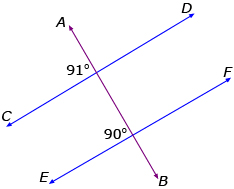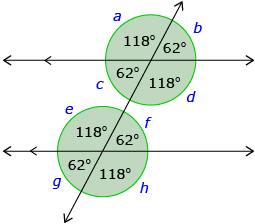Lesson 6
1. Lesson 6
1.6. Explore 2
Module 2: Logic and Geometry
Self-Check 1
In each diagram, is CD parallel to EF? Explain how you know.
a. 
Answer
b. 
Answer
Sue also observed some relationships between pairs of angles formed by transversals and parallel lines. Based on her observations from Try This 2 and Try This 3, Sue concluded that the interior angles on the same side of a transversal that intersects a pair of parallel lines are supplementary. (Supplementary angles add up to 180°.) These are sometimes referred to as consecutive interior angles because they are next to one another. A quick way to find these angles is to draw the letter C on the diagram (either backwards or forwards).

Self-Check 2
There are a number of pairs of supplementary angles in addition to consecutive interior angles.
Identify the supplementary angles in the following diagram. Answer

Instead of using the Angles and Lines applet and the Parallel Lines applet to gather evidence, Quinn decided to use a protractor to measure the angles formed by the intersecting lines on the fox and geese game board. Quinn focused on the relationship between alternate angles on the game board. Specifically, he considered the alternate exterior angles.
alternate angles: two non-adjacent angles on opposite sides of a transversal
There are alternate interior angles and alternate exterior angles. Alternate angles form a Z shape.

alternate exterior angles: two exterior angles formed between two lines and a transversal, on opposite sides of the transversal

Watch the animation Angles of Play to see the evidence Quinn collected and the conjecture he developed based on his evidence.
